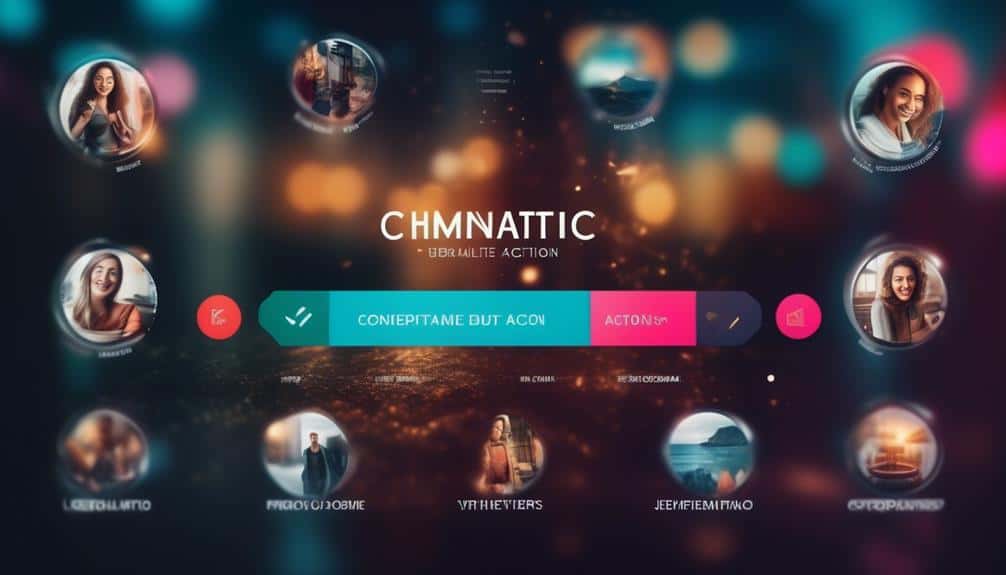Exclusive Reveal: Unleash the Power of Personalization in Your Email Campaigns Now
Are your email campaigns lacking the personal touch that could truly make them stand out?
It's time to unlock the potential of personalization and take your email marketing to new heights.
In this exclusive reveal, you'll discover the power of personalization in email campaigns and how it can significantly improve your engagement and conversion rates.
From understanding your audience to crafting personalized subject lines and dynamic content, we'll guide you through the key steps to create highly tailored email campaigns that resonate with your recipients.
Don't miss out on this opportunity to enhance your email marketing strategy and achieve better results.
Key Takeaways
- Personalization in email campaigns is crucial for capturing audience attention and forging connections.
- Collecting relevant data on demographics, preferences, and behaviors helps in understanding subscribers and delivering targeted content.
- Segmenting the email list based on interests and behaviors enhances relevance and increases engagement rates.
- Crafting personalized subject lines and utilizing dynamic content can maximize engagement, open rates, and conversions.
The Importance of Personalization

Personalization is the key to capturing your audience's attention and forging meaningful connections in your email campaigns. In today's digital age, where customers are bombarded with countless marketing messages, personalization strategies for small businesses have become more crucial than ever. By tailoring your emails to the individual needs and interests of your customers, you can create a more personalized experience that resonates with them on a deeper level.
One of the most powerful personalization strategies for small businesses is to segment your email list. By dividing your subscribers into specific groups based on demographics, interests, or behaviors, you can deliver more targeted and relevant content. This not only increases the chances of engagement but also enhances customer satisfaction and loyalty.
The future of personalization in email marketing looks promising. With advancements in technology, such as artificial intelligence and machine learning, businesses can now leverage data to create hyper-personalized experiences. By analyzing customer behavior and preferences, you can automate email campaigns that deliver dynamic and customized content. This not only saves time but also ensures that each customer receives the right message at the right time.
Understanding Your Audience
To effectively personalize your email campaigns, you must first understand your audience and their unique needs and preferences. This understanding will allow you to create targeted messaging and personalized recommendations that truly resonate with your subscribers.
Here are four key strategies to help you gain a deeper understanding of your audience:
- Collect data: Start by gathering information about your subscribers, such as demographics, purchase history, and browsing behavior. This data will provide valuable insights into their preferences and interests.
- Conduct surveys and feedback: Engage with your audience by asking for their opinions and feedback. Surveys can help you uncover their pain points, preferences, and expectations. This information will enable you to tailor your email content accordingly.
- Analyze email metrics: Dive into your email analytics to uncover patterns and trends. Look at open rates, click-through rates, and conversions to understand what types of content resonate most with your audience. Use this data to refine your messaging and improve engagement.
- Segment your audience: Divide your subscriber list into smaller segments based on common characteristics or behaviors. This will allow you to send more targeted and personalized recommendations to each group, increasing the relevance and effectiveness of your email campaigns.
Collecting Relevant Data

Now that you have a deeper understanding of your audience, it's time to start collecting relevant data to further personalize your email campaigns. Data collection techniques are essential in obtaining the information you need to create targeted and compelling content for your subscribers. By utilizing customer insights, you can gather valuable information about their preferences, interests, and behaviors, allowing you to tailor your emails to meet their specific needs.
There are various data collection techniques available to you. One effective method is conducting surveys or feedback forms to gather direct feedback from your subscribers. This can provide you with valuable insights into their preferences and opinions.
Another technique is analyzing customer interactions and engagement with your emails and website. By tracking open rates, click-through rates, and other metrics, you can gain insights into what content resonates with your audience and adjust your email campaigns accordingly.
Furthermore, you can leverage customer data from your CRM system to personalize your emails even further. By integrating your email marketing platform with your CRM, you can access valuable information such as purchase history, demographics, and past interactions. This allows you to segment your audience and send targeted emails based on their specific interests and behaviors.
Collecting relevant data is crucial for effective email personalization. By utilizing customer insights and employing data collection techniques, you can create highly personalized email campaigns that resonate with your audience and drive engagement. Remember, serving your audience's needs by providing customized experiences will ultimately lead to increased customer satisfaction and loyalty.
Segmenting Your Email List
By segmenting your email list, you can deliver targeted content to specific groups of subscribers, increasing the effectiveness of your email campaigns. Here are four reasons why segmenting your email list is crucial for success:
- Improved Relevance:
Segmenting your email list allows you to send tailored content to each group of subscribers based on their interests, preferences, and behaviors. By providing relevant content, you demonstrate that you understand your subscribers and can cater to their specific needs.
- Increased Engagement:
When you deliver personalized emails to your subscribers, they're more likely to open, click, and interact with your content. By segmenting your list and sending targeted emails, you can capture your audience's attention and encourage them to take action, leading to higher engagement rates.
- Higher Conversion Rates:
By delivering personalized and relevant content, you can nurture your subscribers and guide them through the customer journey. With targeted emails, you can provide the right information at the right time, increasing the chances of converting subscribers into customers.
- Improved Customer Satisfaction:
By segmenting your list and providing personalized content, you show your subscribers that you value their individual needs and preferences. This personalized approach enhances the customer experience, leading to increased satisfaction and loyalty.
Segmenting your email list is a powerful strategy that can significantly enhance the effectiveness of your email campaigns. By delivering personalized and relevant content, you can engage your subscribers, increase conversion rates, and ultimately build stronger relationships with your audience.
Crafting Personalized Subject Lines

Are your email subject lines falling flat?
It's time to take your email campaigns to the next level by crafting personalized subject lines that grab attention and maximize engagement.
By tailoring your subject lines to each recipient's interests, preferences, and behaviors, you can create a sense of relevance and urgency that compels them to open your emails.
Don't miss out on the power of personalization – start crafting subject lines that make an impact today.
Tailoring Subject Lines
Craft subject lines that are tailored specifically to each individual recipient, capturing their attention and increasing the likelihood of engagement with your email campaign. Personalized subject lines have the power to improve open rates and increase click-through rates.
Here are four tips to help you craft compelling subject lines:
- Use the recipient's name: Addressing your audience by their name instantly grabs their attention and makes them feel valued.
- Segment your audience: Divide your email list into smaller groups based on demographics, interests, or previous interactions. This allows you to create subject lines that are relevant and resonate with each specific segment.
- Leverage past interactions: Incorporate past purchases, browsing history, or previous engagement to create subject lines that are personalized and tailored to the recipient's preferences.
- Create a sense of urgency: Use words like 'limited time offer' or 'exclusive deal' to create a sense of urgency, compelling recipients to open your email.
Maximizing Email Engagement
To maximize email engagement, personalize your subject lines to capture the attention of each recipient and entice them to open your email. With the power of data analytics and email automation, you can craft subject lines that speak directly to your audience's interests and needs. By incorporating personalization, you show your recipients that you understand them and value their individuality. This creates a sense of connection and trust, increasing the likelihood that they will engage with your email. To help you get started, here's a table that showcases different ways you can personalize your subject lines based on recipient data:
| Recipient Segment | Personalized Subject Line Example |
|---|---|
| Location | "Exclusive offer for [City] residents only!" |
| Purchase History | "We think you'll love this based on your past orders" |
| Interests | "Your favorite [Interest] just got restocked!" |
| Birthday | "Happy birthday [Name]! Enjoy this special treat" |
| Engagement Level | "We miss you, [Name]! Here's something just for you" |
Tailoring Email Content to Individual Preferences
Want to take your email campaigns to the next level? Tailoring your email content to individual preferences is the key.
By utilizing personalized email subject lines, dynamic content blocks, and behavioral targeting techniques, you can create a highly engaging and relevant experience for your subscribers.
Imagine sending emails that speak directly to their interests, preferences, and behaviors, resulting in higher open rates, click-through rates, and ultimately, conversions.
Let's explore how you can leverage these powerful tactics to maximize the impact of your email campaigns.
Personalized Email Subject Lines
Maximize the impact of your email campaigns by tailoring your subject lines to each individual's preferences. Personalized email subject lines are a powerful way to capture your audience's attention and increase open rates.
Here are four effective techniques to make your subject lines stand out:
- Use the recipient's name: Adding a personal touch by including their name in the subject line creates a sense of familiarity and connection.
- Segment your audience: Divide your email list into different groups based on interests, demographics, or past purchases. Craft subject lines that resonate with each segment's specific preferences.
- Incorporate dynamic content: Utilize real-time data to personalize subject lines based on recent interactions or browsing behavior, making them more relevant and enticing.
- A/B testing: Experiment with different subject lines to identify which ones generate the highest open rates. Tailor subject lines based on the results to continually optimize your email campaigns.
Dynamic Content Blocks
Tailor your email content to individual preferences with dynamic content blocks, creating a personalized and engaging experience for each recipient. Personalization strategies are key to connecting with your audience and increasing engagement in email campaigns.
Dynamic content strategies allow you to dynamically change the content of your emails based on each recipient's preferences, behavior, or demographics. By segmenting your email list and creating different content blocks for each segment, you can deliver highly relevant and targeted messages that resonate with your subscribers.
For example, you can show different product recommendations based on previous purchases, location-based offers, or personalized greetings. By using dynamic content blocks, you can make your emails more relevant, increase open and click-through rates, and ultimately drive more conversions.
Start implementing dynamic content strategies in your email campaigns and see the difference it makes in engaging your audience.
Behavioral Targeting Techniques
To truly connect with your email recipients, it's essential to understand their individual preferences and tailor your content accordingly. By implementing behavioral targeting strategies in your personalized email marketing, you can create a more engaging and relevant experience for each recipient.
Here are four techniques to help you get started:
- Segment your audience: Divide your subscriber list based on demographics, past purchases, and browsing behavior. This allows you to send targeted emails that resonate with each group.
- Track engagement: Monitor how recipients interact with your emails, such as opens, clicks, and conversions. This data helps you understand their interests and tailor future content to their preferences.
- Personalize subject lines and content: Use dynamic tags to insert recipients' names into subject lines and email copy. This personal touch grabs their attention and increases open rates.
- Automate follow-ups: Set up automated email sequences based on specific actions or triggers. For example, send a follow-up email to customers who abandoned their shopping carts. This increases the chances of conversion.
Dynamic Content and Personalized Recommendations
Using personalized recommendations and dynamic content in your email campaigns can significantly boost engagement and conversion rates. By tailoring your content to the specific needs and interests of your subscribers, you can create a more personalized and relevant experience for them. This not only increases the chances of them opening and clicking through your emails, but also helps to build a stronger connection and trust with your audience.
One effective way to implement personalized recommendations is by using real-time personalization. This involves analyzing the browsing behavior and purchase history of your subscribers to deliver relevant product recommendations in your emails. For example, if a subscriber has recently purchased a pair of shoes, you can automatically include personalized recommendations for complementary products like socks or shoe care products. This not only enhances the user experience but also increases the likelihood of a repeat purchase.
Dynamic content is another powerful tool that can take your email campaigns to the next level. With dynamic content, you can create personalized email templates that adapt to the preferences and behaviors of your subscribers. For example, you can display different product images and descriptions based on the subscriber's previous interactions with your website or email campaigns. This level of personalization shows your subscribers that you understand their individual needs and preferences, making them more likely to engage with your content and take the desired action.
Incorporating personalized recommendations and dynamic content into your email campaigns can make a big difference in driving engagement and conversions. By providing your subscribers with relevant and personalized content, you can create a more enjoyable and impactful experience that ultimately leads to increased loyalty and revenue. So, don't miss out on the opportunity to unleash the power of personalization in your email campaigns now.
Creating Personalized Call-to-Action (CTA) Buttons

Personalized call-to-action (CTA) buttons are a powerful way to grab your subscribers' attention and compel them to take action in your email campaigns. By incorporating customized design and personalized offers into your CTA buttons, you can create a sense of exclusivity and urgency that will drive engagement and conversions.
Here are four tips to help you create effective personalized CTA buttons:
- Tailor the design: Customize the look and feel of your CTA buttons to match your brand and the overall aesthetic of your email. Use colors, fonts, and images that resonate with your audience and evoke the desired emotions.
- Craft compelling copy: Personalize the text on your CTA buttons to make them more relevant and appealing to your subscribers. Use language that speaks directly to their needs and desires, and highlight the benefits they'll receive by clicking.
- Add urgency: Incorporate time-limited offers or limited stock notifications into your CTA buttons to create a sense of urgency. This will motivate your subscribers to take immediate action and not miss out on the opportunity.
- Test and optimize: Continuously monitor the performance of your personalized CTA buttons and make data-driven decisions to improve their effectiveness. A/B testing different designs, copy variations, and placement can help you find the winning combination that generates the highest click-through rates.
A/B Testing Personalized Campaigns
When it comes to optimizing your email campaigns, nothing beats the power of A/B testing to ensure you're delivering the most personalized and effective content to your subscribers. A/B testing is a method where you compare two versions of an email to see which one performs better. By testing different elements such as subject lines, email copy, and personalized content, you can identify what resonates most with your audience and make data-driven decisions to improve your campaigns.
A/B testing allows you to measure the effectiveness of your personalization strategies. You can test different personalization elements, such as using the subscriber's name in the subject line or tailoring the email content based on their preferences or past behavior. By analyzing the results, you can gain insights into what personalization strategies work best for your audience, helping you refine your approach and deliver more relevant and engaging content.
To run an effective A/B test, start by identifying the specific elements you want to test. It could be different subject lines, email layouts, or even the order of the content. Next, create two versions of your email with the only difference being the element you're testing. Split your subscriber list into two random groups and send each version to a different group. Monitor the performance metrics, such as open rates, click-through rates, and conversions, to determine which version performs better.
A/B testing is an ongoing process, and it's essential to continuously test and refine your email campaigns. By leveraging the power of personalization and A/B testing, you can optimize your campaigns to deliver the most impactful and personalized content that resonates with your subscribers.
Analyzing and Optimizing Personalization Results

Now that you've successfully implemented personalized email campaigns and conducted A/B testing, it's time to analyze and optimize the results.
By utilizing data-driven personalization techniques, you can gain valuable insights into your audience's preferences and behaviors. This information will enable you to refine your email content, subject lines, and call-to-action buttons to improve engagement and drive better results.
Don't miss out on the opportunity to maximize the power of personalization and take your email campaigns to the next level.
Data-Driven Personalization Techniques
By analyzing and optimizing the results of your data-driven personalization techniques, you can unlock the true power of personalization in your email campaigns. Here are four key strategies to help you make the most of your data and improve the effectiveness of your personalization tactics:
- Segment your audience: Use your data to divide your subscribers into smaller groups based on demographics, interests, or behavior. This allows you to tailor your email content to each segment, increasing relevancy and engagement.
- Personalize subject lines and preheaders: Craft compelling subject lines and preheaders that speak directly to your subscribers' needs and interests. Use their name or include personalized content based on their previous interactions with your brand.
- Dynamic content: Take advantage of dynamic content blocks that allow you to show different content to different subscribers within the same email. Use data to personalize product recommendations, offers, or even images.
- A/B testing: Continuously test and optimize your personalization efforts by running A/B tests. Experiment with different personalization tactics, such as using first names in the email body or personalizing the call-to-action button text, and measure the impact on your click-through rates and conversions.
Improving Email Engagement
To improve email engagement and optimize the results of your personalization efforts, analyze and refine your data-driven strategies.
One key aspect to focus on is improving email deliverability, ensuring that your messages reach the intended recipients' inboxes. Start by regularly monitoring your email deliverability rates and identify any potential issues or patterns that may be causing your emails to land in spam folders. Take steps to improve your sender reputation, such as using reputable email service providers and authenticating your email domain.
Another important factor to consider is increasing open rates. Personalize your subject lines and email content based on the recipient's preferences, past interactions, and behavior. Utilize A/B testing to experiment with different subject lines, email designs, and call-to-action buttons to determine what resonates best with your audience.
Frequently Asked Questions
How Can I Measure the Success of Personalization in My Email Campaigns?
You can measure the success of personalization in your email campaigns by analyzing the results. Look at open rates, click-through rates, and conversion rates. These metrics will give you insights into how effective your personalization efforts are.
What Are Some Best Practices for Collecting Relevant Data for Personalization?
To collect relevant data effectively, start by understanding your audience's preferences. Utilize customer surveys, website analytics, and purchase history to gather insights. By tailoring your email campaigns to individual needs, you can enhance personalization and boost engagement.
Are There Any Tools or Software That Can Help With Segmenting My Email List?
There are plenty of email segmentation tools and software available to help you effectively segment your email list. These tools can streamline the process and ensure that your campaigns are targeted and personalized.
How Can I Ensure That My Personalized Subject Lines Are Effective in Engaging Recipients?
To increase open rates and improve click through rates, focus on crafting personalized subject lines that grab recipients' attention. Use their name, mention their interests, and create a sense of urgency. Experiment and track results to find what works best.
What Are Some Common Mistakes to Avoid When Implementing Personalization in Email Campaigns?
When implementing personalization in your email campaigns, common mistakes to avoid include using incorrect data, overpersonalizing, and neglecting to test. Follow these tips for success: validate your data, segment your audience, and track your results.
Conclusion
Now that you understand the power of personalization in your email campaigns, it's time to unleash its potential.
By understanding your audience, collecting relevant data, and segmenting your email list, you can create tailored content that resonates with each individual subscriber.
Crafting personalized subject lines, using dynamic content, and creating customized CTAs will further enhance your campaign's effectiveness.
Don't forget to analyze and optimize your results through A/B testing.
Embrace personalization and watch your email campaigns thrive like never before.
Get started today!








